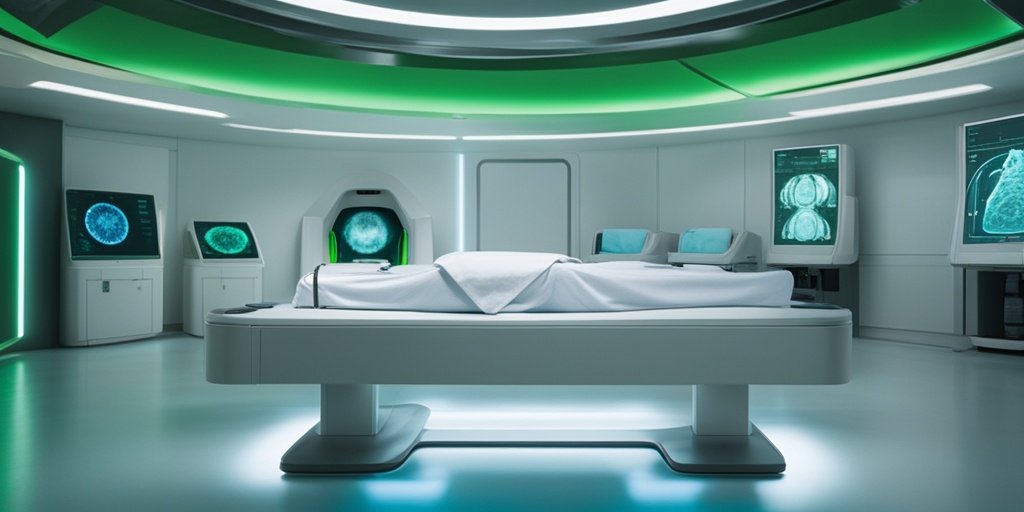⚡ Quick Summary
A recent study investigates the use of artificial intelligence (AI) to create a CT-free quantitative thyroid SPECT for diagnosing thyrotoxicosis. This innovative approach aims to reduce radiation exposure while maintaining diagnostic accuracy compared to traditional SPECT/CT methods.
🔍 Key Details
- 📊 Participants: Approximately 160 adult patients with thyrotoxicosis
- ⚙️ Technology: AI-based CT-free SPECT using convolutional neural networks
- 🏆 Primary Endpoint: Accuracy of diagnosing Graves’ disease using TcTU
- 📅 Study Duration: Until 152 completed datasets are enrolled
🔑 Key Takeaways
- 🤖 AI integration could significantly reduce CT-induced radiation exposure.
- 📈 Non-inferiority study aims to validate the effectiveness of CT-free SPECT.
- 🔍 Focus on thyrotoxicosis differentiates between Graves’ disease and destructive thyroiditis.
- 🧪 Tc-99m pertechnetate is used for quantitative thyroid imaging.
- 🗂️ Ethical approval obtained from multiple institutions in South Korea.
- 📊 Secondary endpoints include accuracy for destructive thyroiditis and predicting antithyroid drug needs.
- 🌍 Multicentre approach enhances the study’s robustness and generalizability.
- 🆔 Clinical Trial Registration: KCT0008387.

📚 Background
Thyrotoxicosis is a condition characterized by excessive thyroid hormones, often leading to serious health issues. Traditional diagnostic methods, such as SPECT/CT, are effective but involve exposure to radiation, which poses risks to patients. The integration of artificial intelligence in imaging techniques presents an opportunity to enhance diagnostic capabilities while minimizing these risks.
🗒️ Study
This multicentre, prospective, non-inferiority study is being conducted in the Republic of Korea. It aims to evaluate the diagnostic accuracy of a novel AI-based CT-free SPECT compared to the conventional SPECT/CT. The study will involve screening approximately 160 eligible participants who are adults with thyrotoxicosis but without prior thyroid conditions.
📈 Results
The primary outcome will assess the accuracy of diagnosing Graves’ disease using TcTU from both CT-free SPECT and SPECT/CT. The study’s design ensures that the accuracy difference between the two methods will be rigorously evaluated, with a focus on ensuring that the CT-free method does not fall below a 95% confidence limit of -0.1.
🌍 Impact and Implications
If successful, this study could lead to a paradigm shift in the diagnosis of thyrotoxicosis, offering a safer alternative to traditional imaging methods. The potential reduction in radiation exposure is particularly significant for vulnerable populations, such as young patients and those requiring multiple imaging studies. This advancement could pave the way for broader applications of AI in medical imaging.
🔮 Conclusion
The integration of AI in CT-free quantitative thyroid SPECT represents a promising advancement in the field of nuclear medicine. By prioritizing patient safety and diagnostic accuracy, this study could significantly enhance the management of thyrotoxicosis. Continued research and validation of these technologies are essential for their successful implementation in clinical practice.
💬 Your comments
What are your thoughts on the use of AI in medical imaging? Do you believe this approach could transform diagnostic practices? 💬 Share your insights in the comments below or connect with us on social media:
Artificial intelligence-based CT-free quantitative thyroid SPECT for thyrotoxicosis: study protocol of a multicentre, prospective, non-inferiority study.
Abstract
INTRODUCTION: Technetium thyroid uptake (TcTU) measured by single-photon emission CT/CT (SPECT/CT) is an important diagnostic tool for the differential diagnosis of Graves’ disease and destructive thyroiditis. Artificial intelligence (AI) may reduce CT-induced radiation exposure by substituting the role of CT in attenuation correction (AC) and thyroid segmentation, thus realising CT-free SPECT. This study aims to compare the diagnostic accuracy for the differential diagnosis of thyrotoxicosis between CT-free SPECT and SPECT/CT.
METHODS AND ANALYSIS: The AI-based CT-free SPECT is a single-blind, multicentre, prospective, non-inferiority, clinical trial with a paired design conducted in the Republic of Korea. Eligible participants are adult (≥19 years old) thyrotoxicosis patients without a previous history of hyperthyroidism or hypothyroidism. Approximately 160 subjects will be screened for quantitative thyroid SPECT/CT using Tc-99m pertechnetate. CT-free thyroid SPECT will be realised using only SPECT data by the trained convolutional neural networks. TcTU will be calculated by SPECT/CT and CT-free SPECT in each subject. The primary endpoint is the accuracy of diagnosing Graves’ disease using TcTU. The trial will continue until 152 completed datasets have been enrolled to assess whether the 95% (two-sided) lower confidence limit of the accuracy difference (CT-free SPECT accuracy-SPECT/CT accuracy) for Graves’ disease is greater than -0.1. The secondary endpoints include the accuracy of diagnosing destructive thyroiditis and predicting the need for antithyroid drug prescription within 1 month of the SPECT/CT.
ETHICS AND DISSEMINATION: The study protocol has been approved by the institutional review board of Seoul National University Bundang Hospital (IRB No. B-2304-824-301), Konkuk University Medical Center (IRB No. 2023-05-022-006) and Chonnam National University Hospital (IRB No. CNUH-2023-108). Findings will be disseminated as reports, presentations and peer-reviewed journal articles.
TRIAL REGISTRATION NUMBER: KCT0008387, Clinical Research Information Service of the Republic of Korea (CRIS).
Author: [‘Oh D’, ‘Ryoo HG’, ‘Chung HW’, ‘Cho SG’, ‘Kwon K’, ‘Kim JH’, ‘So Y’, ‘Moon JH’, ‘Ahn S’, ‘Lee WW’]
Journal: BMJ Open
Citation: Oh D, et al. Artificial intelligence-based CT-free quantitative thyroid SPECT for thyrotoxicosis: study protocol of a multicentre, prospective, non-inferiority study. Artificial intelligence-based CT-free quantitative thyroid SPECT for thyrotoxicosis: study protocol of a multicentre, prospective, non-inferiority study. 2024; 14:e089552. doi: 10.1136/bmjopen-2024-089552